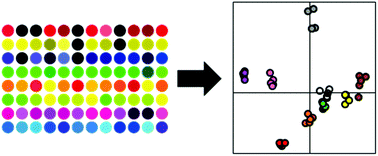Our official English website, www.x-mol.net, welcomes your feedback! (Note: you will need to create a separate account there.)
Fluorescent sensing arrays for cations and anions
Analyst ( IF 4.2 ) Pub Date : 2017-08-30 00:00:00 , DOI: 10.1039/c7an01200d David G. Smith 1, 2, 3 , Inga L. Topolnicki 1, 2, 3 , Vincent E. Zwicker 1, 2, 3 , Katrina A. Jolliffe 1, 2, 3 , Elizabeth J. New 1, 2, 3
Analyst ( IF 4.2 ) Pub Date : 2017-08-30 00:00:00 , DOI: 10.1039/c7an01200d David G. Smith 1, 2, 3 , Inga L. Topolnicki 1, 2, 3 , Vincent E. Zwicker 1, 2, 3 , Katrina A. Jolliffe 1, 2, 3 , Elizabeth J. New 1, 2, 3
Affiliation

|
Array-based sensing methods can be used to distinguish sets of similar analytes, by using a number of non-specific or cross-reactive probes. Following subsequent statistical analysis, patterns or components can be isolated that can be used to unambiguously identify the specific analyte(s) present. Over the past two decades, various arrays for the identification of cations and anions have been reported. These often employ fluorescence methods, owing to good sensitivity and a versatile, easy to read output. The past few years have seen an increase in the number of such studies reported in the literature. This critical review will summarise this recent work, and identify the criteria required for a successful array system. In particular, it will focus on the different types of molecular structures that can be used, the breadth of ions that can be distinguished in a single array, the sensitivity and dynamic range to which they can be identified, and how successfully these aims have been met.
中文翻译:

用于阳离子和阴离子的荧光传感阵列
通过使用许多非特异性或交叉反应性探针,基于阵列的传感方法可用于区分相似的分析物。经过随后的统计分析,可以分离出可用于明确鉴定存在的特定分析物的模式或组分。在过去的二十年中,已经报道了用于识别阳离子和阴离子的各种阵列。由于具有良好的灵敏度和通用的,易于读取的输出,这些方法通常采用荧光方法。在过去的几年中,文献中报道的此类研究的数量有所增加。这项重要的评论将总结最近的工作,并确定成功的阵列系统所需的标准。特别是,它将着重于可以使用的不同类型的分子结构,
更新日期:2017-08-30
中文翻译:

用于阳离子和阴离子的荧光传感阵列
通过使用许多非特异性或交叉反应性探针,基于阵列的传感方法可用于区分相似的分析物。经过随后的统计分析,可以分离出可用于明确鉴定存在的特定分析物的模式或组分。在过去的二十年中,已经报道了用于识别阳离子和阴离子的各种阵列。由于具有良好的灵敏度和通用的,易于读取的输出,这些方法通常采用荧光方法。在过去的几年中,文献中报道的此类研究的数量有所增加。这项重要的评论将总结最近的工作,并确定成功的阵列系统所需的标准。特别是,它将着重于可以使用的不同类型的分子结构,


























 京公网安备 11010802027423号
京公网安备 11010802027423号